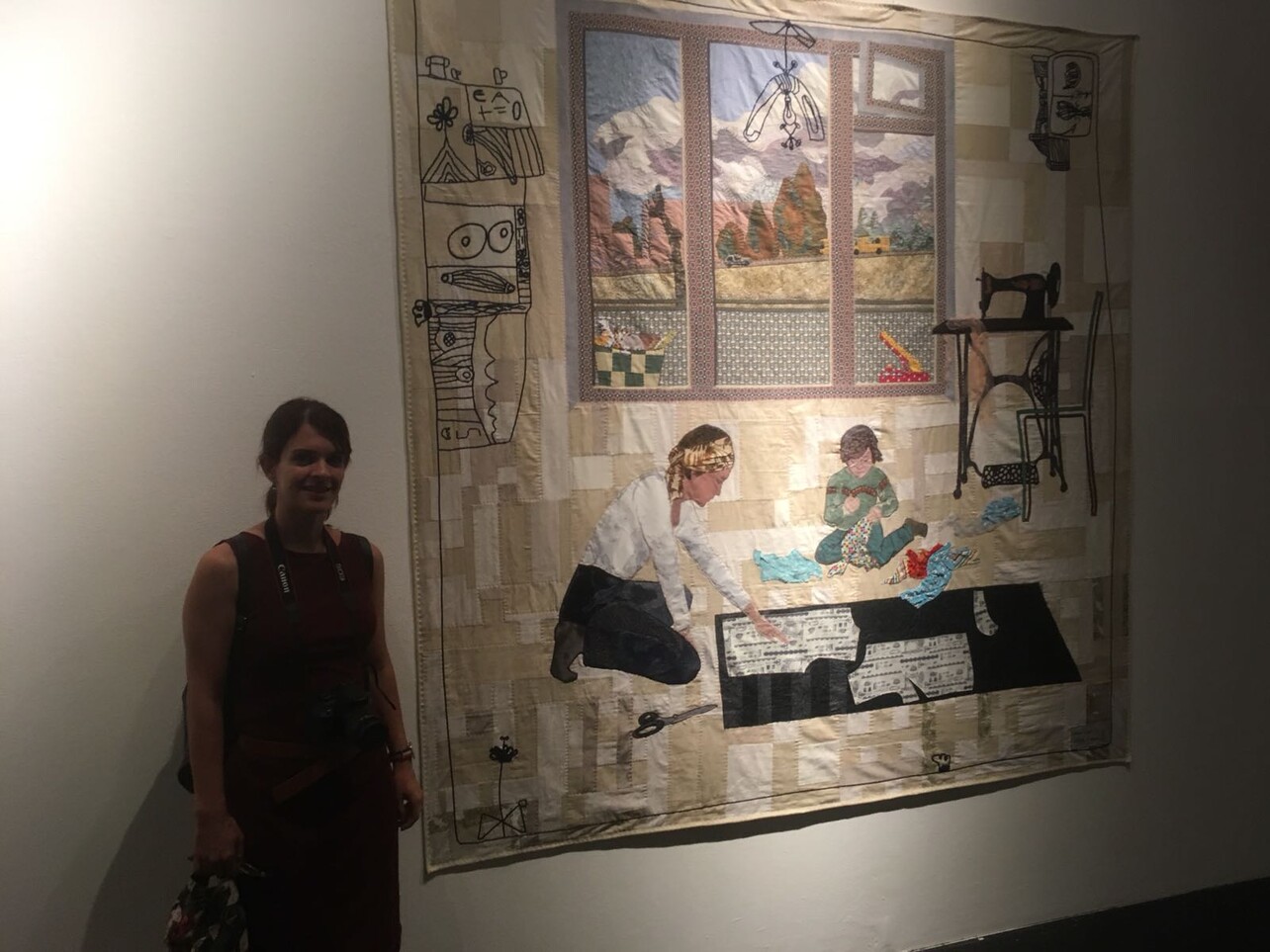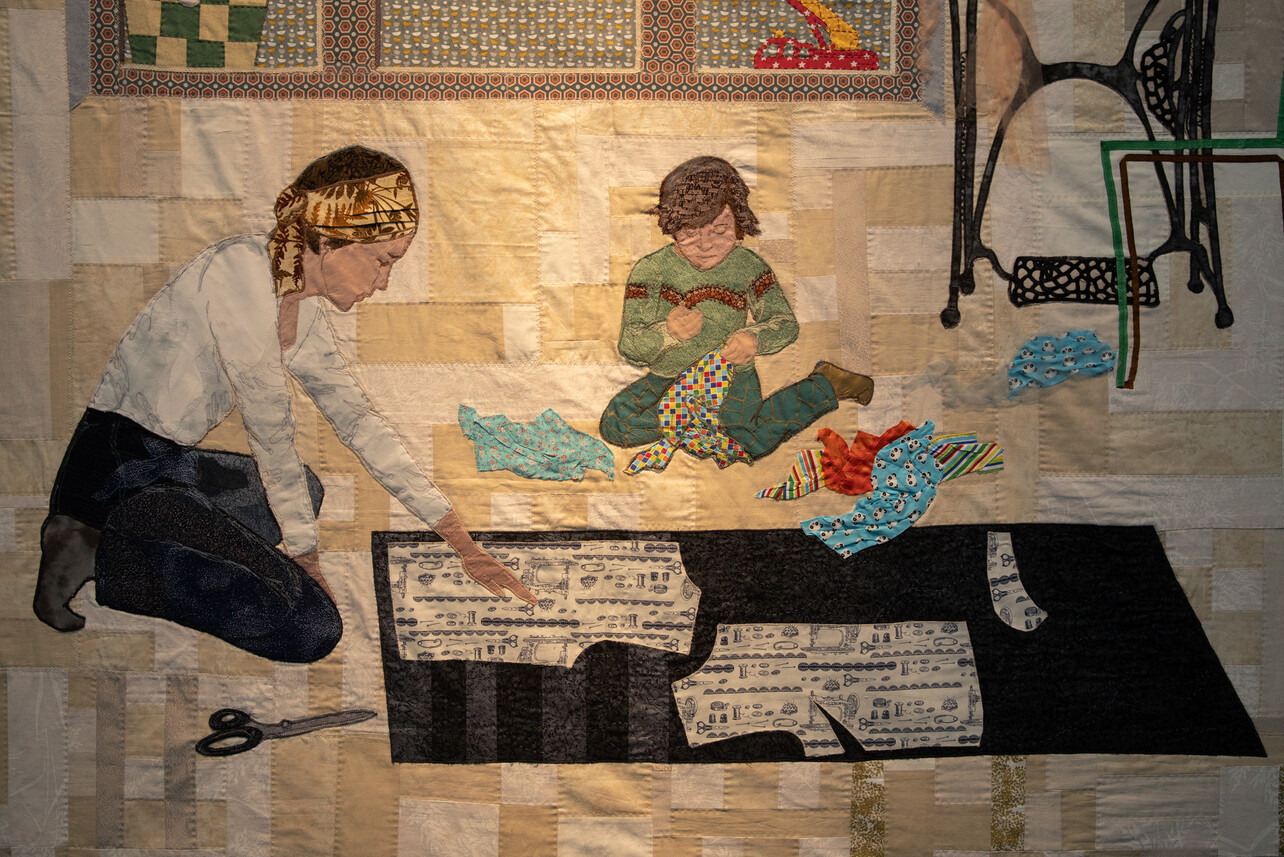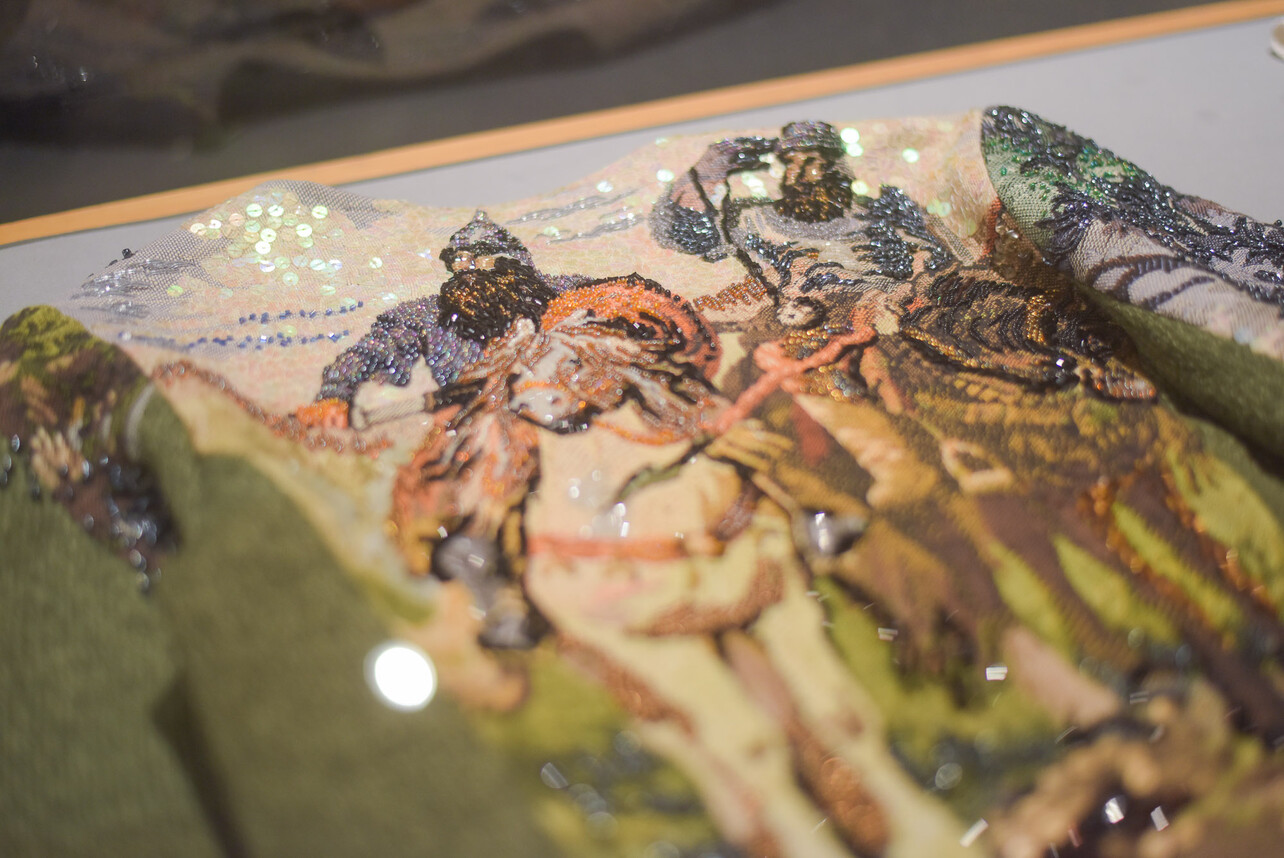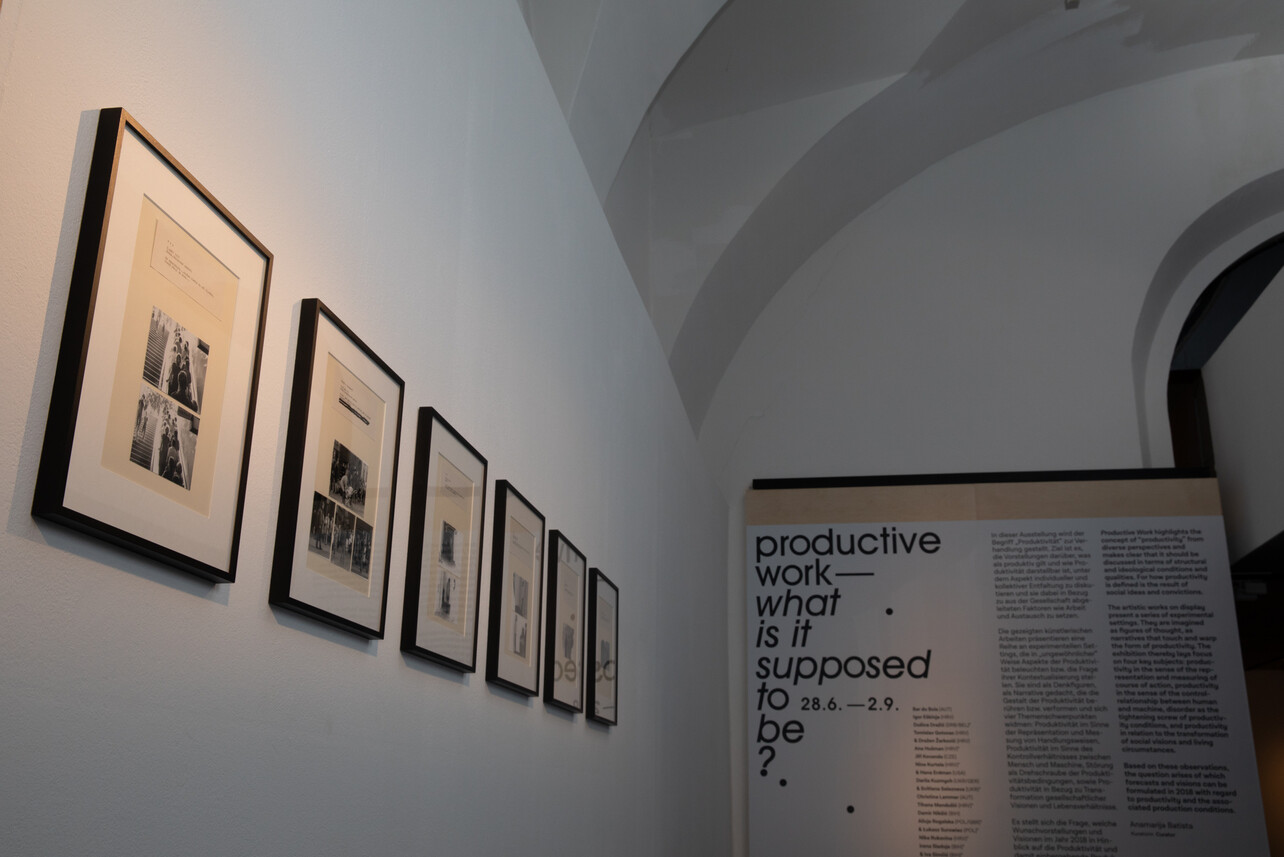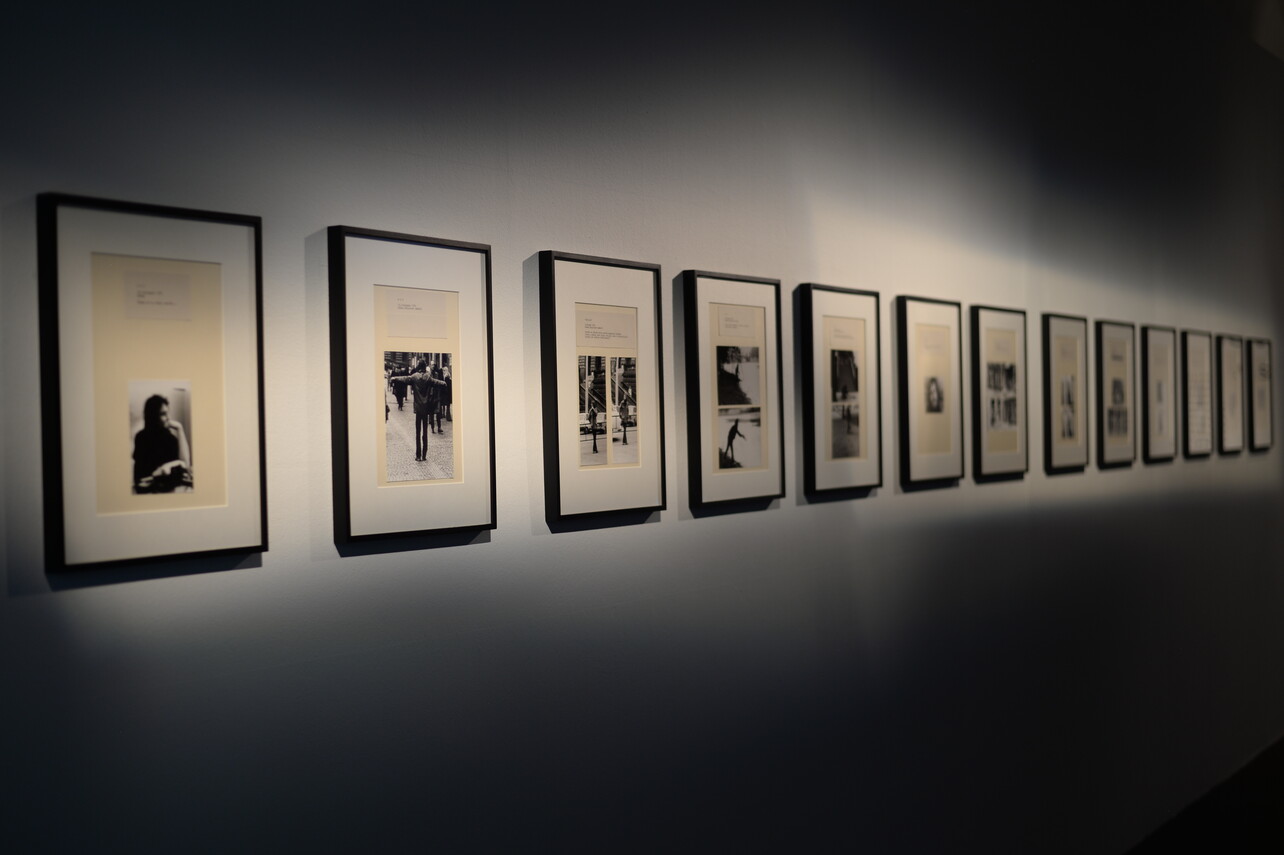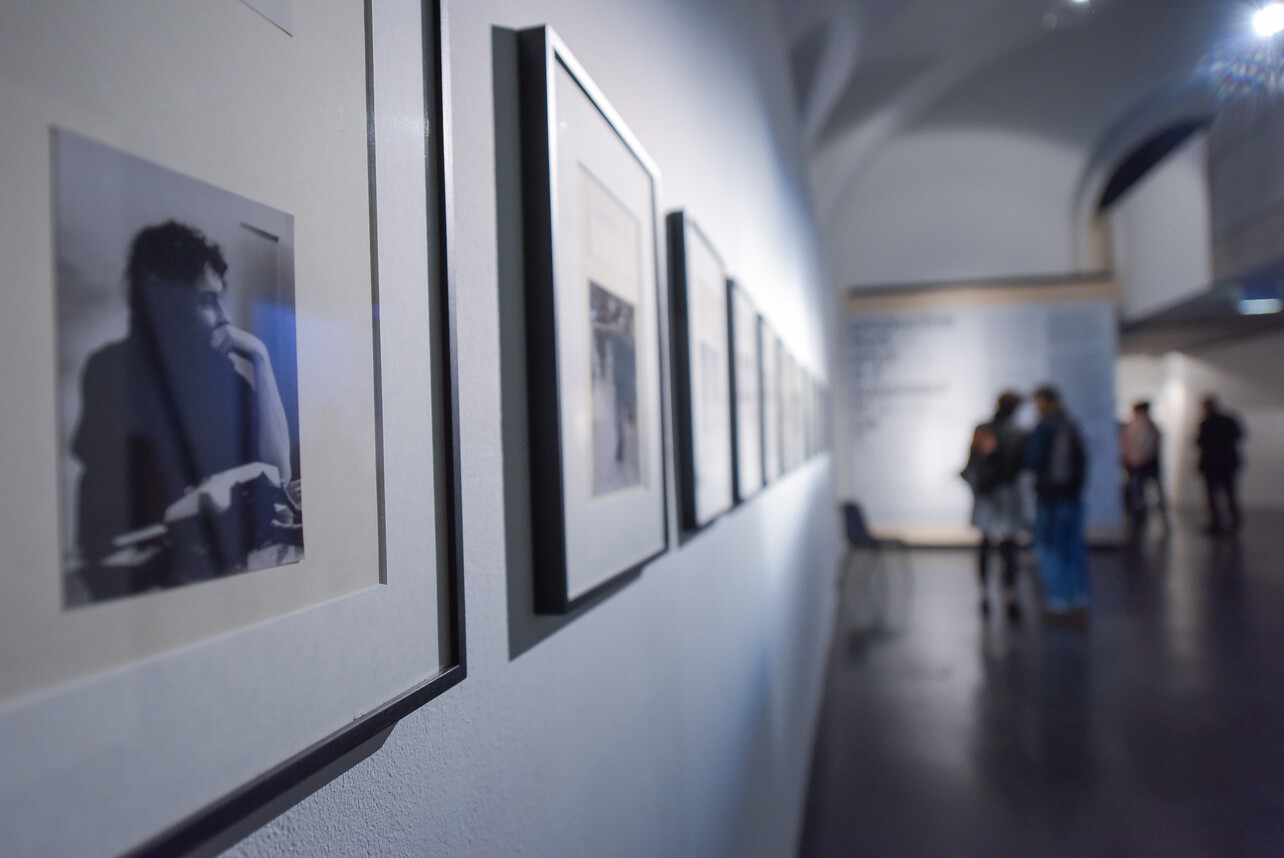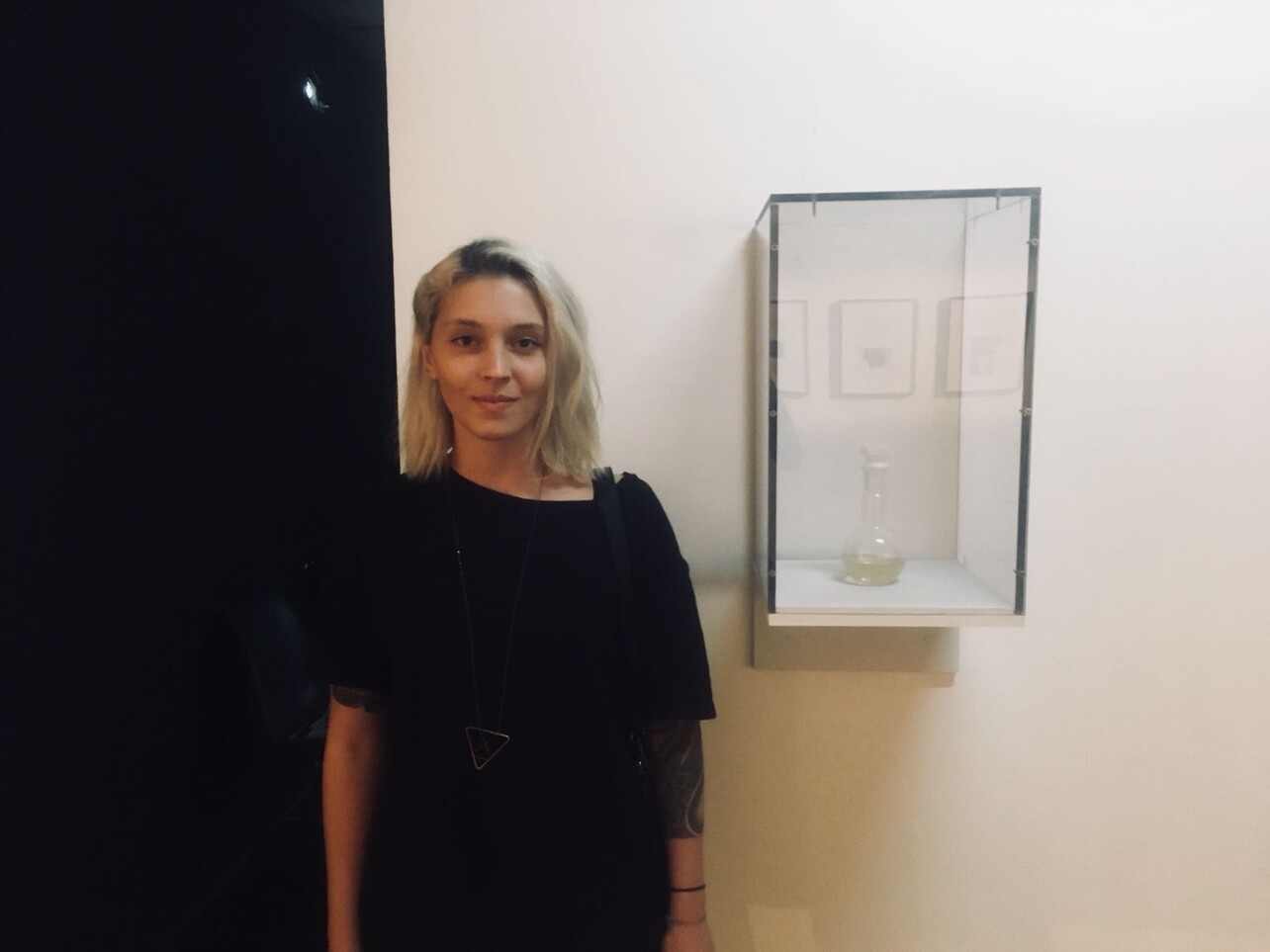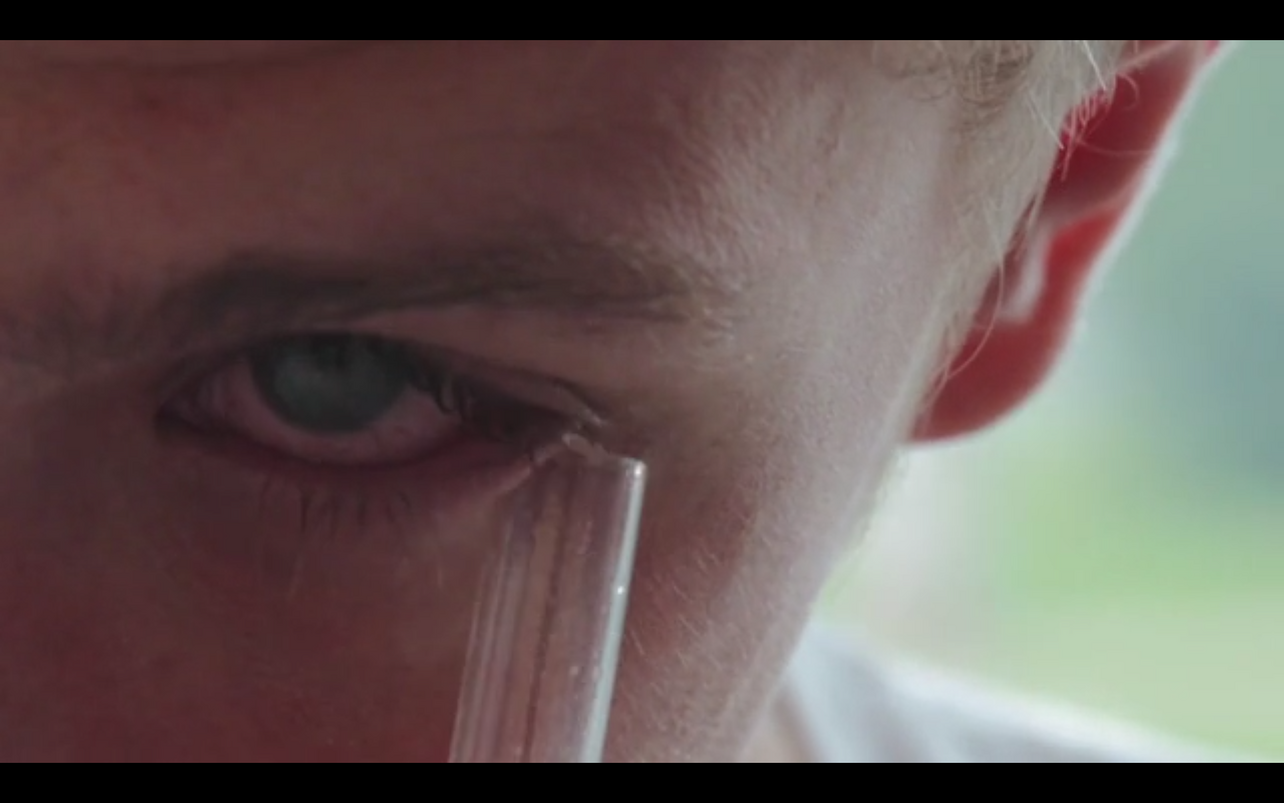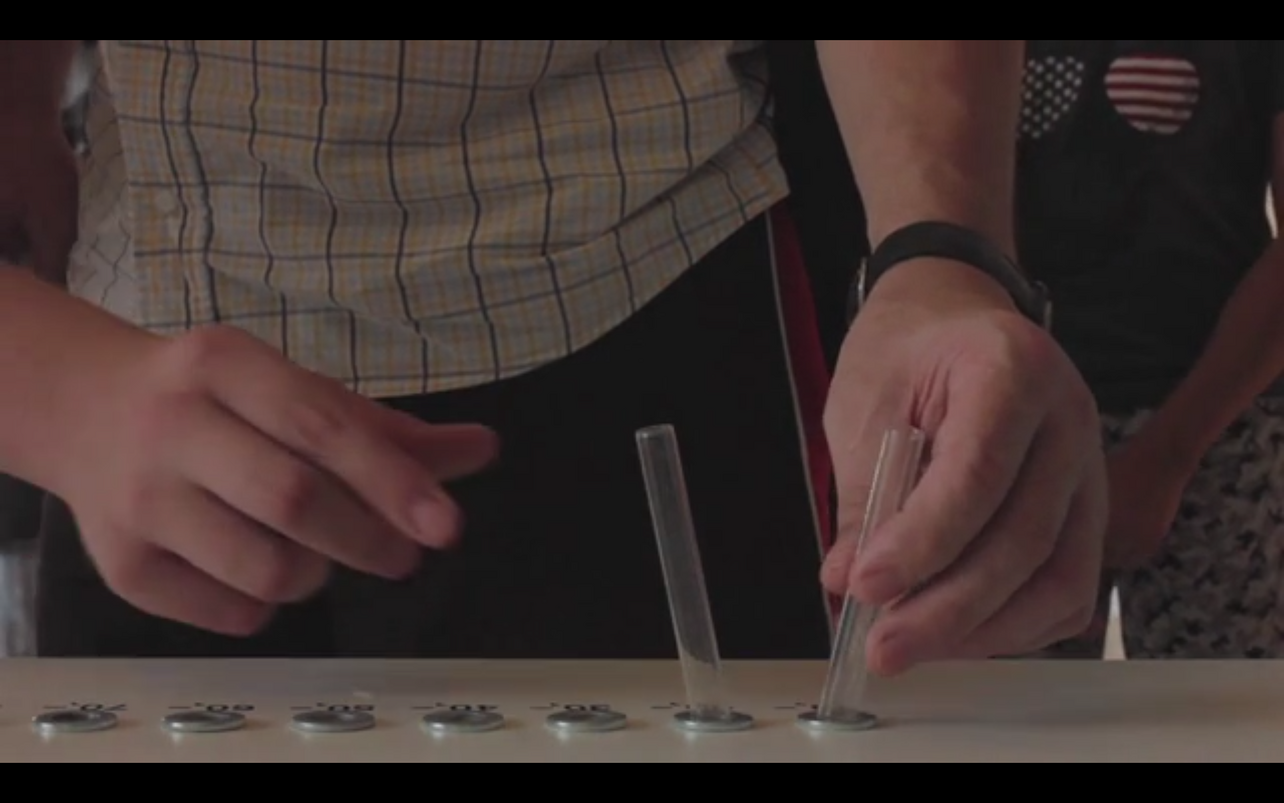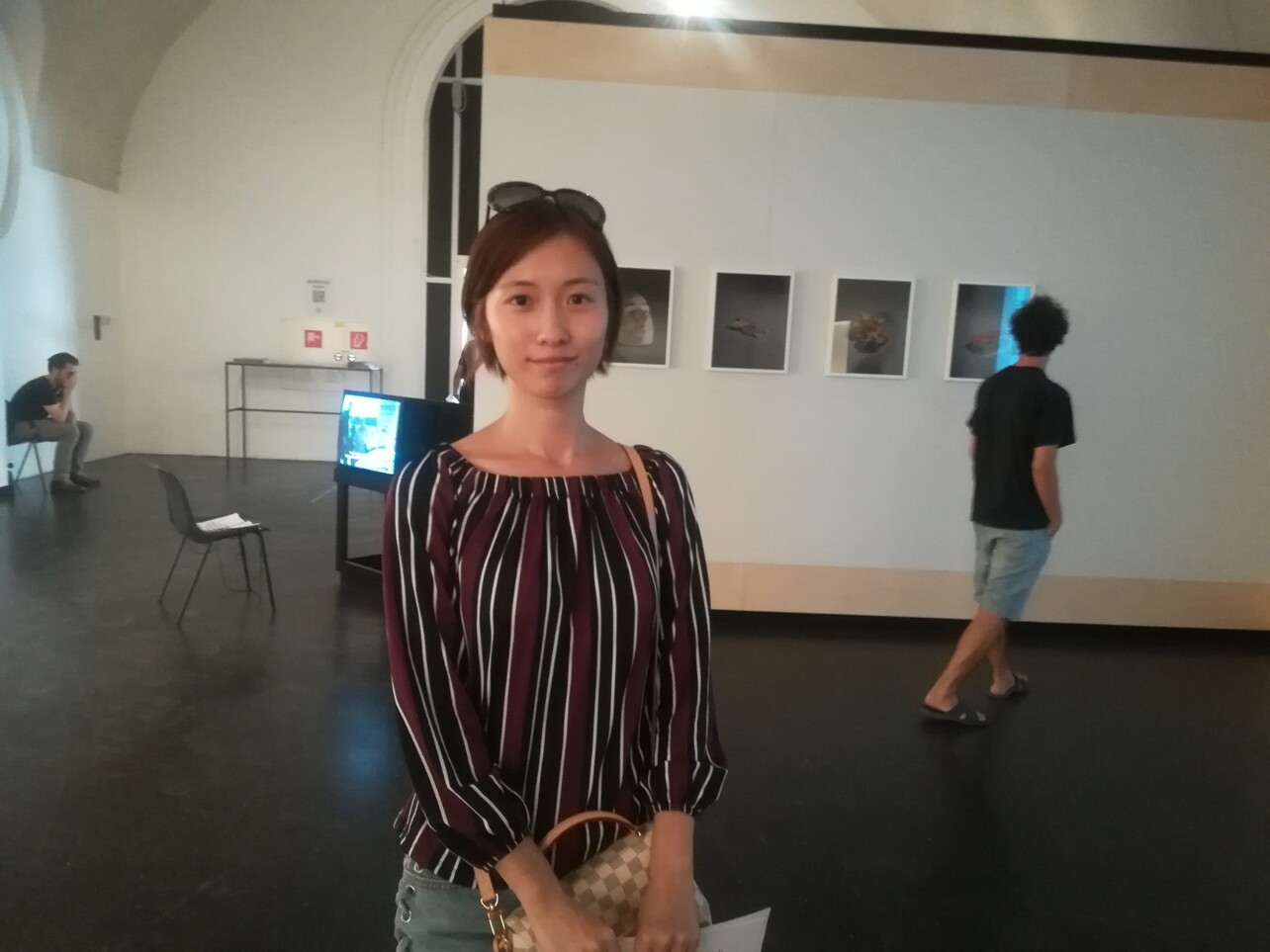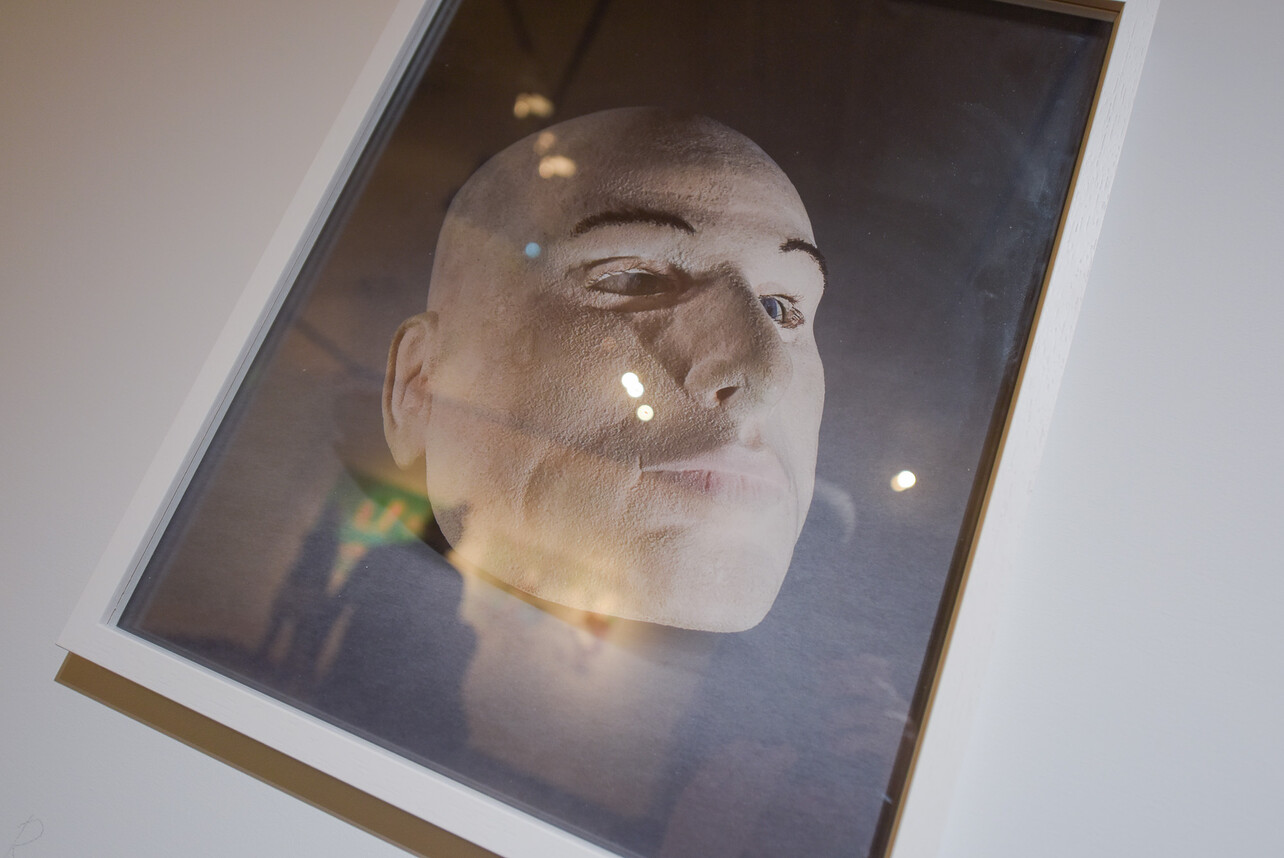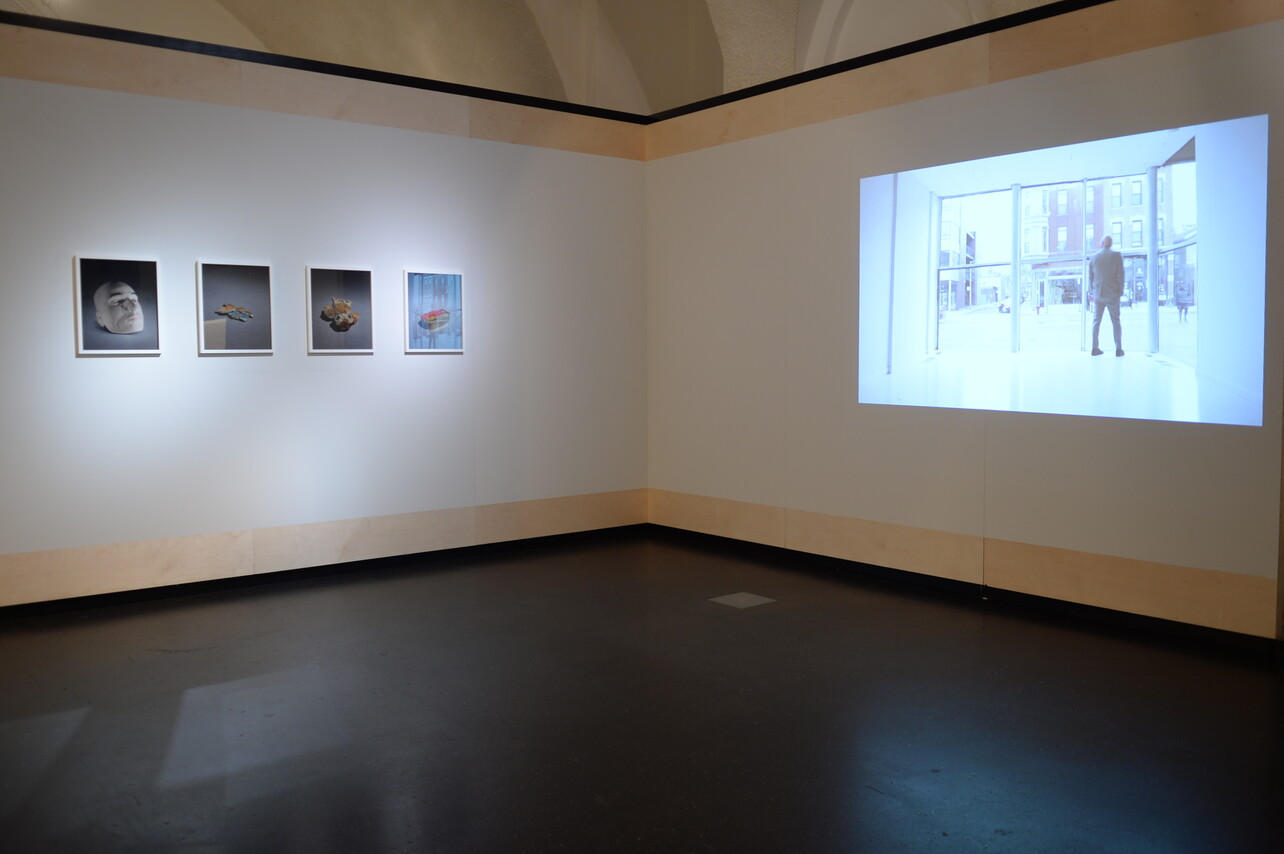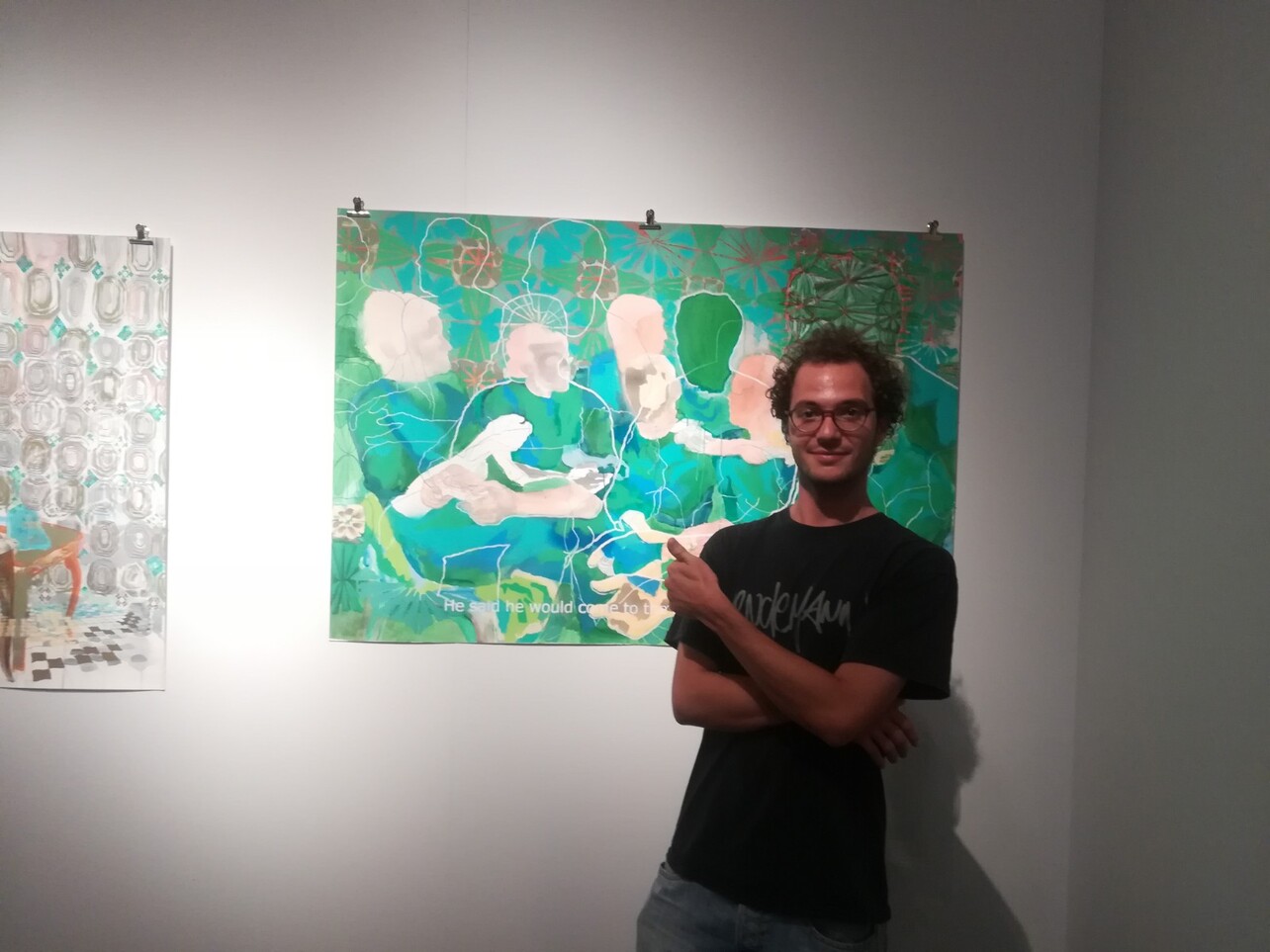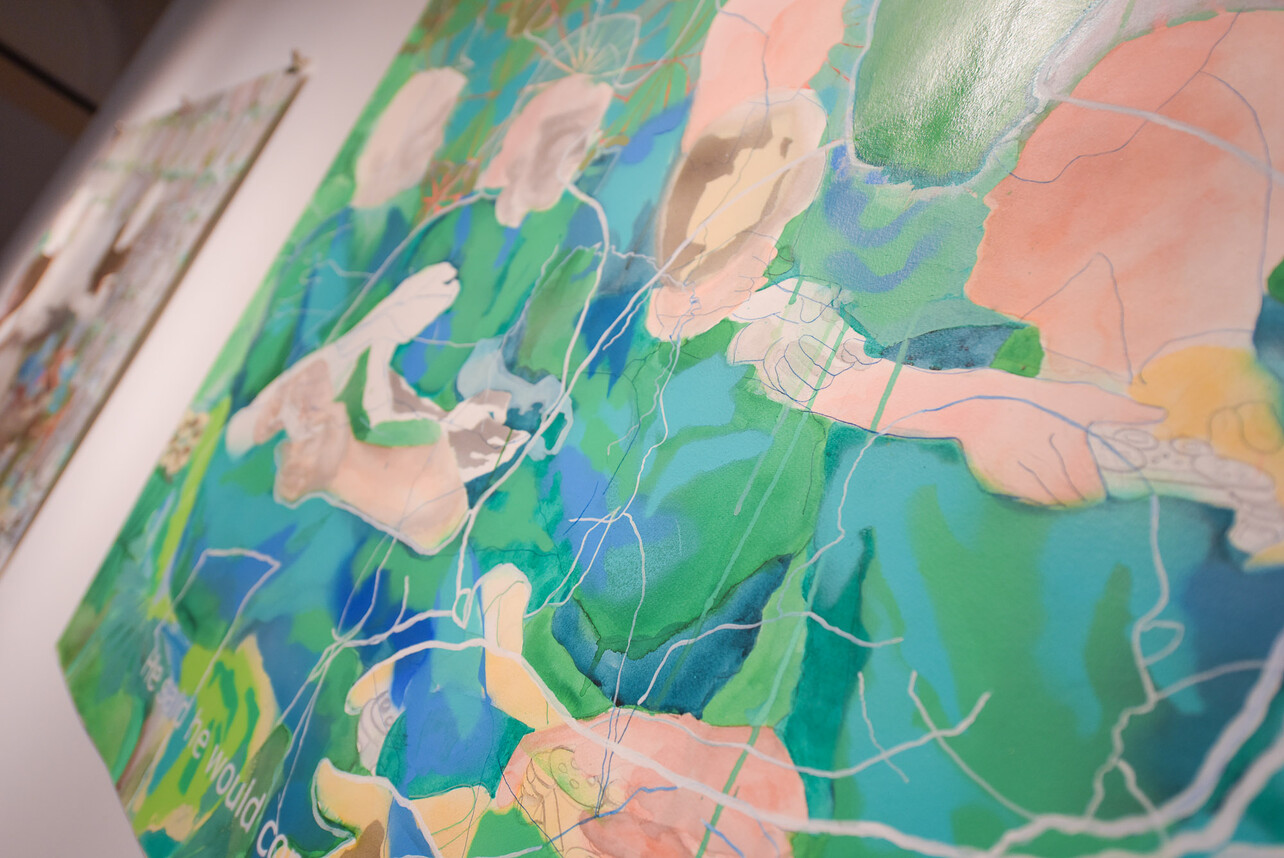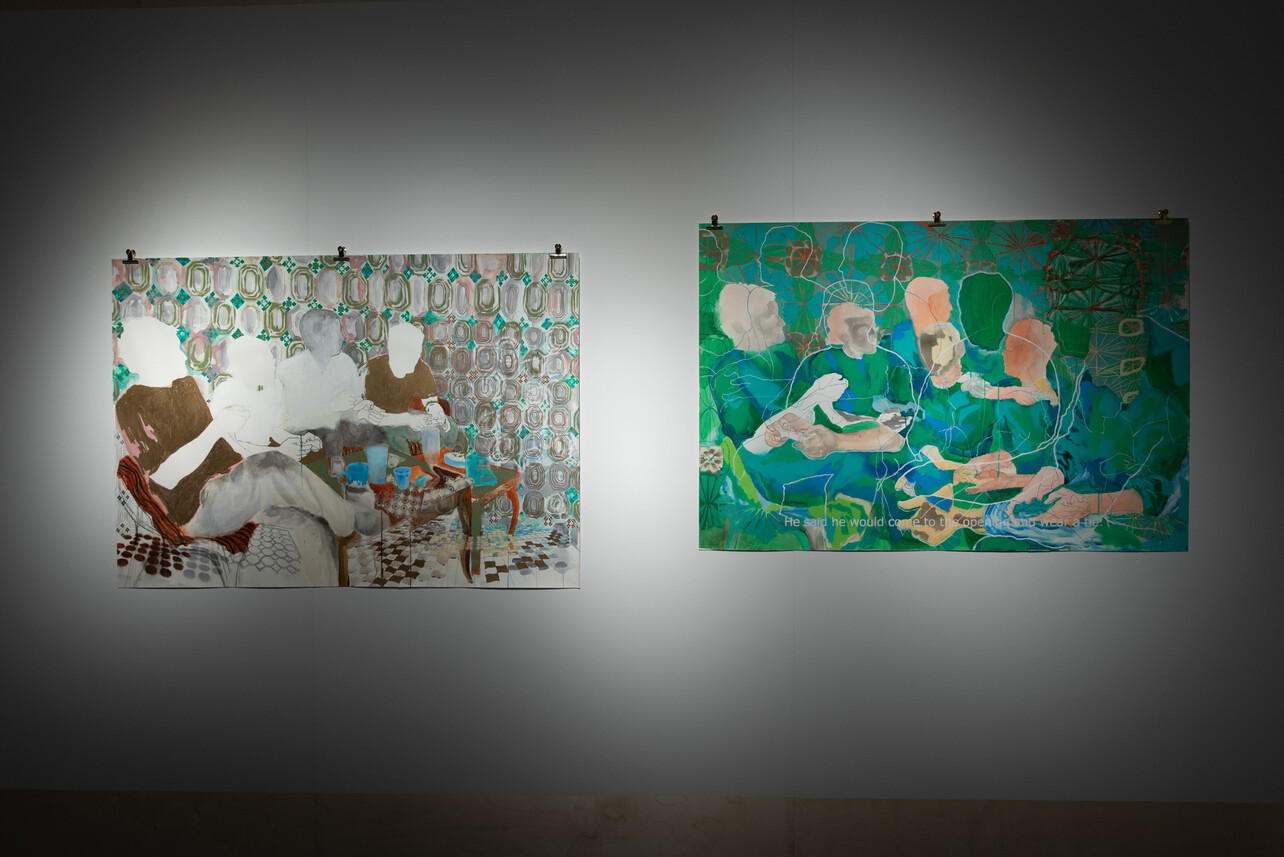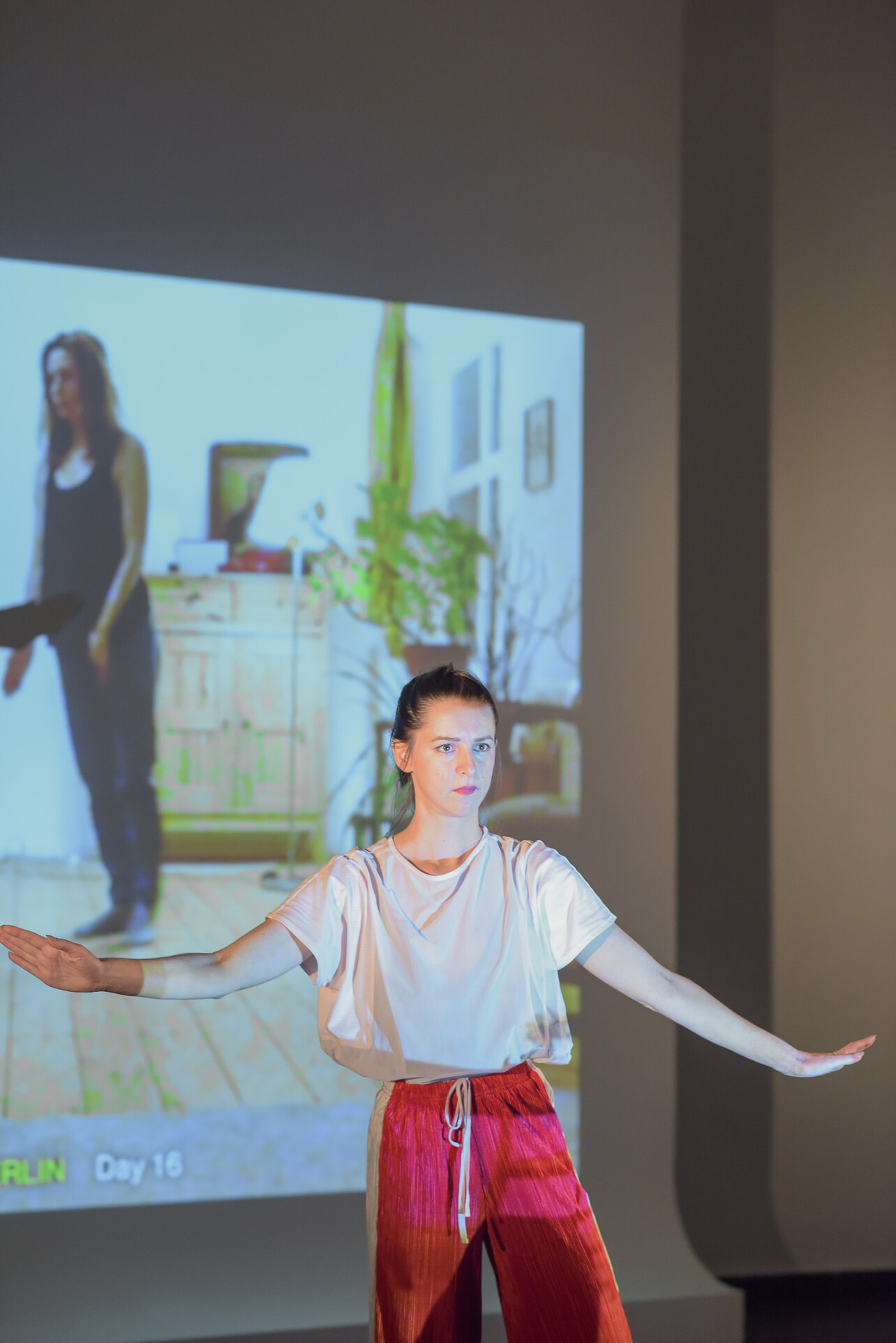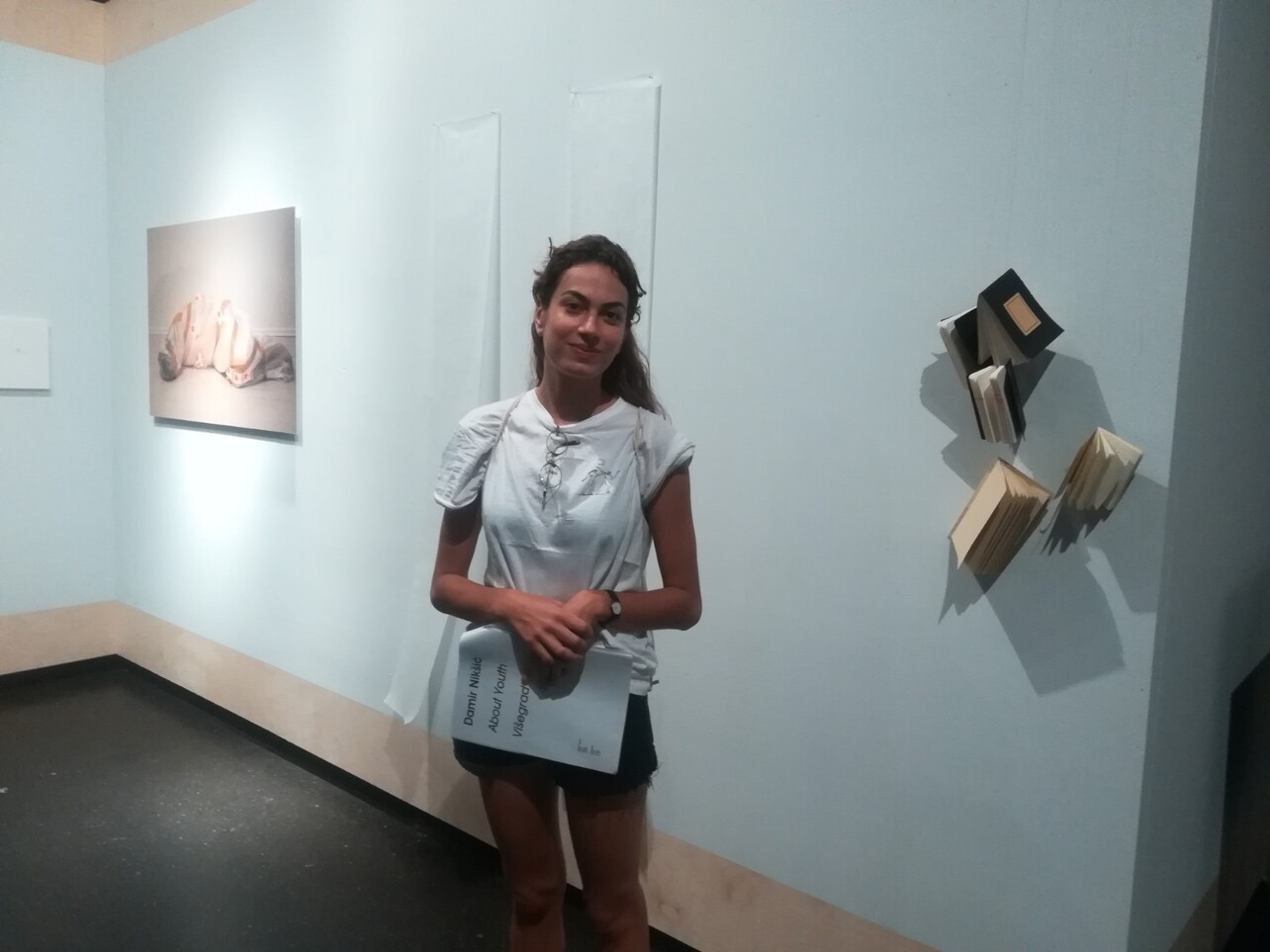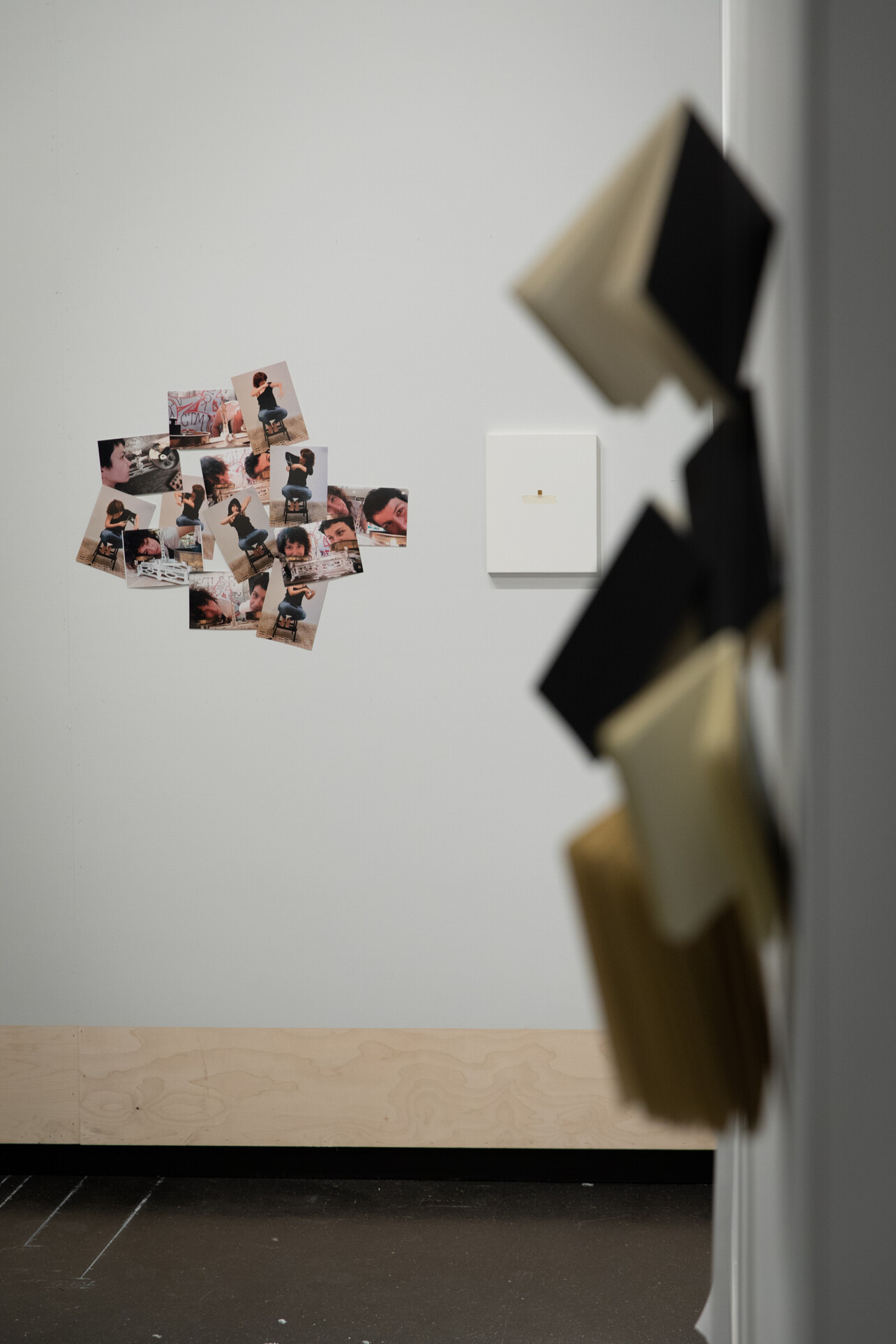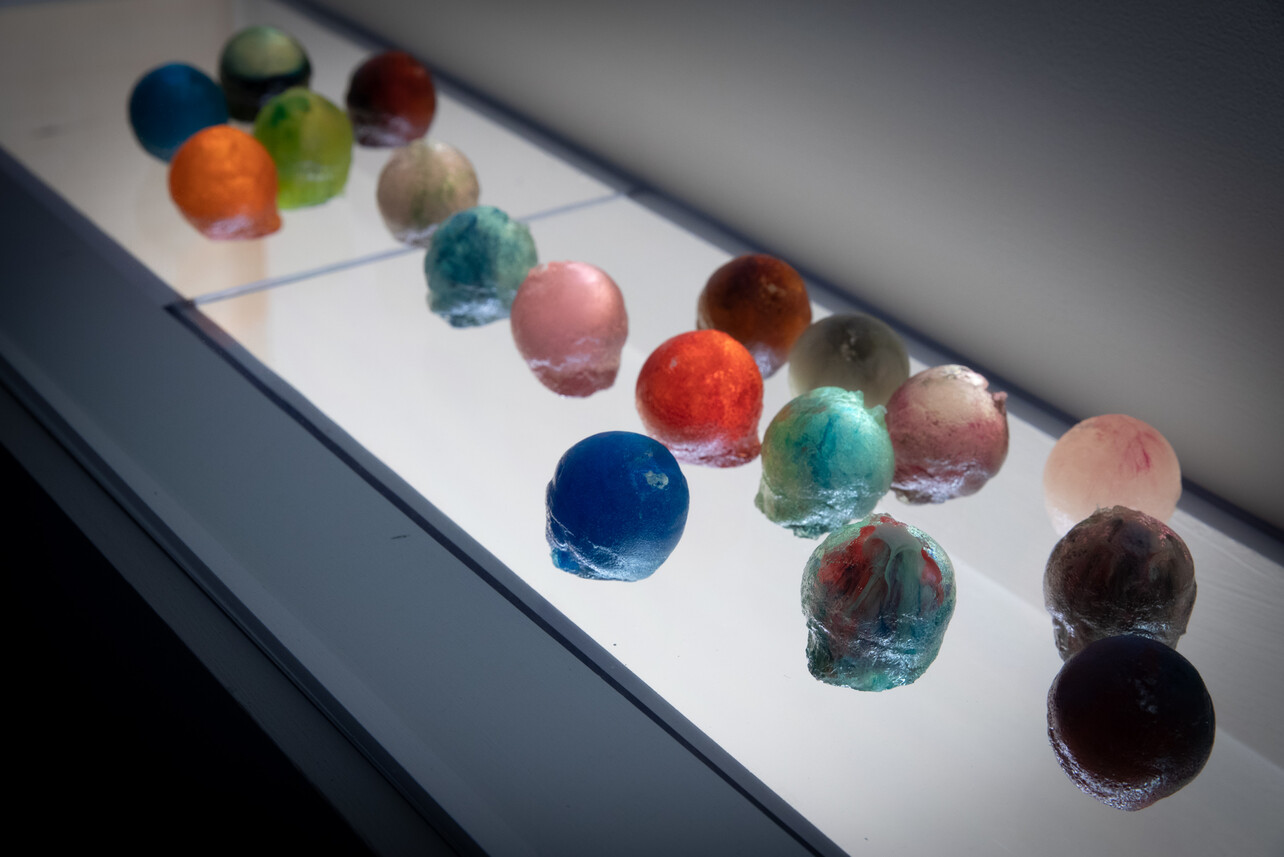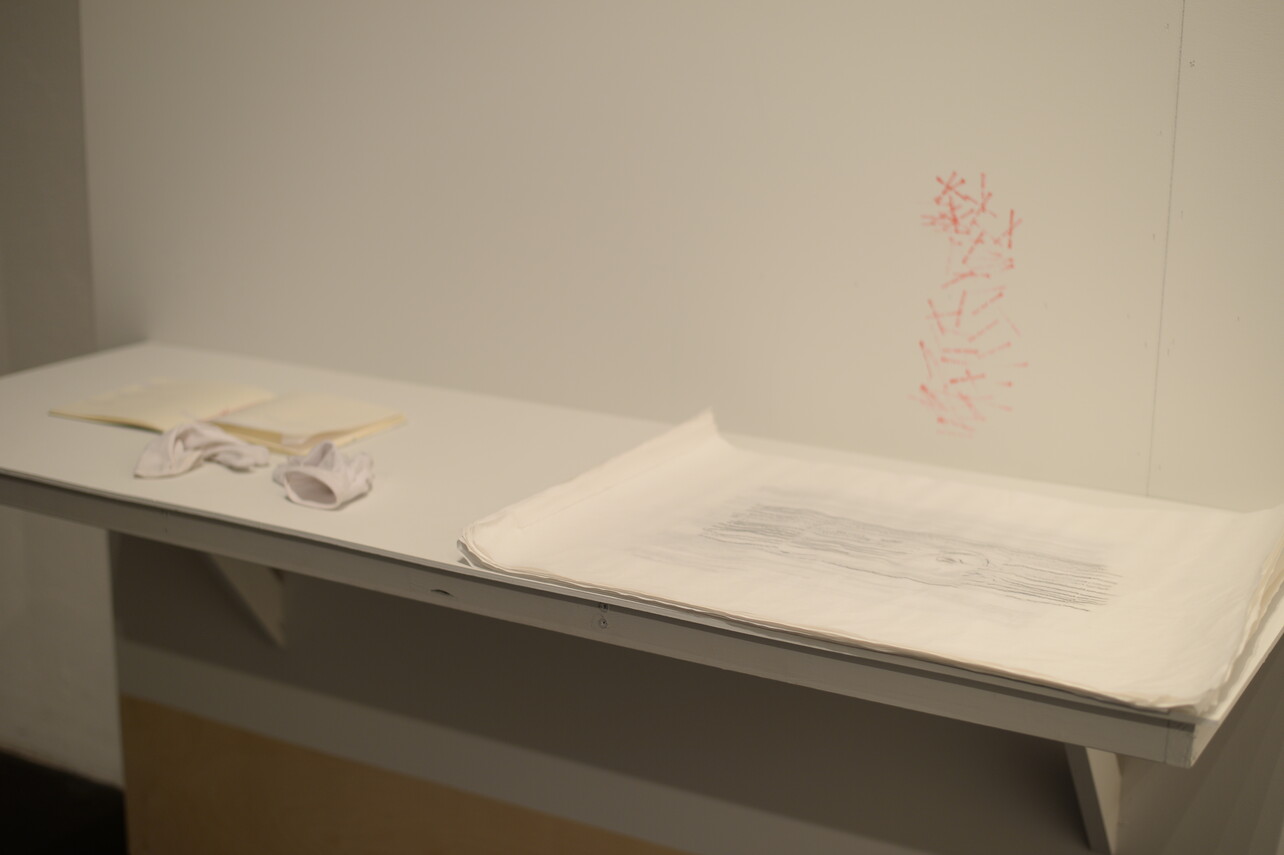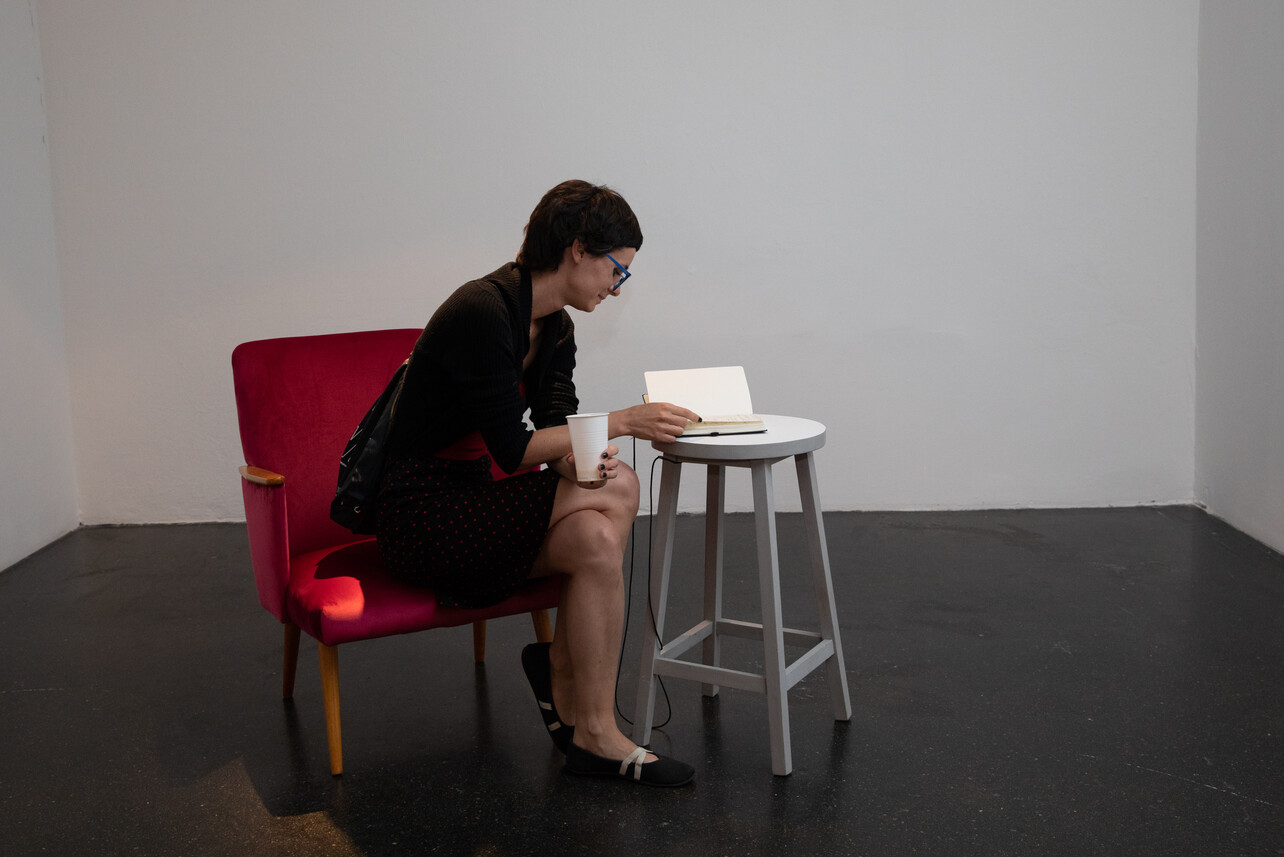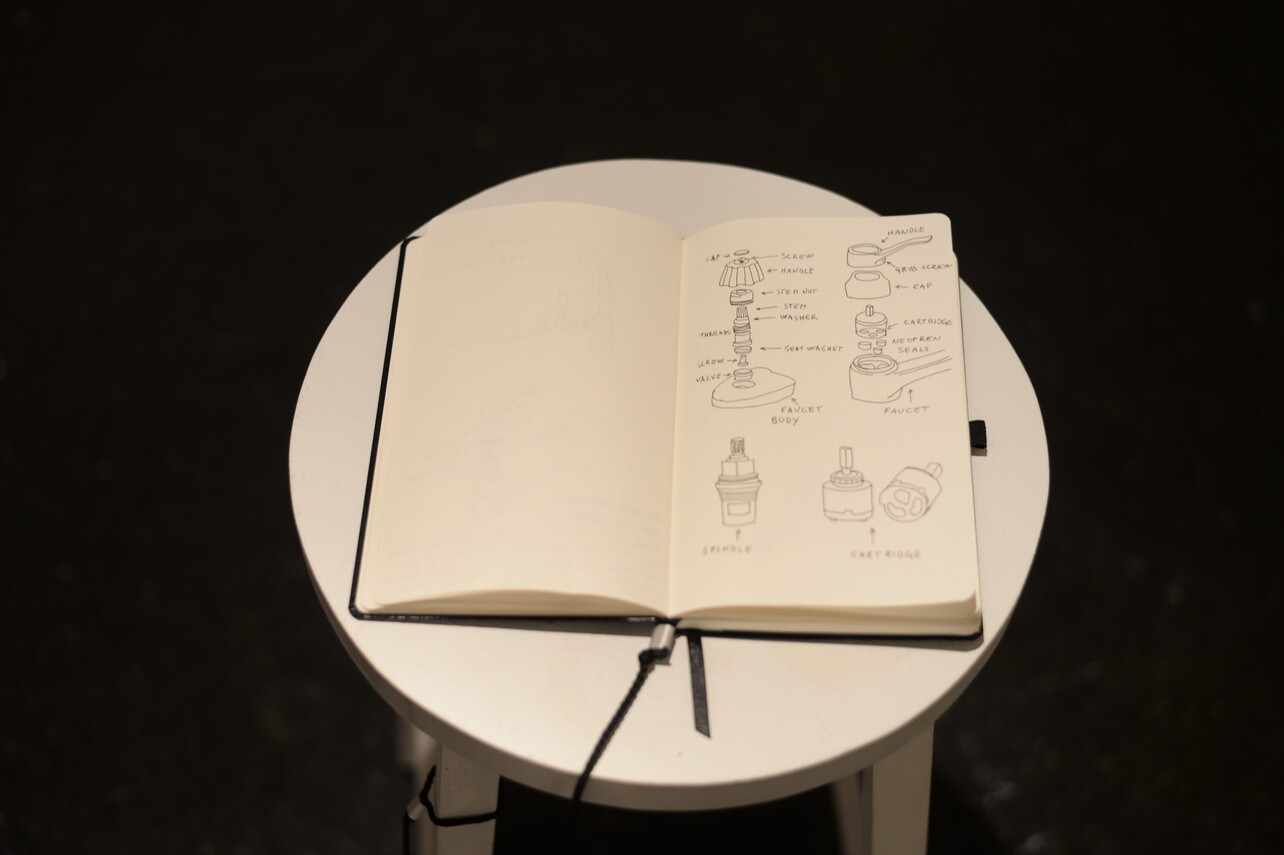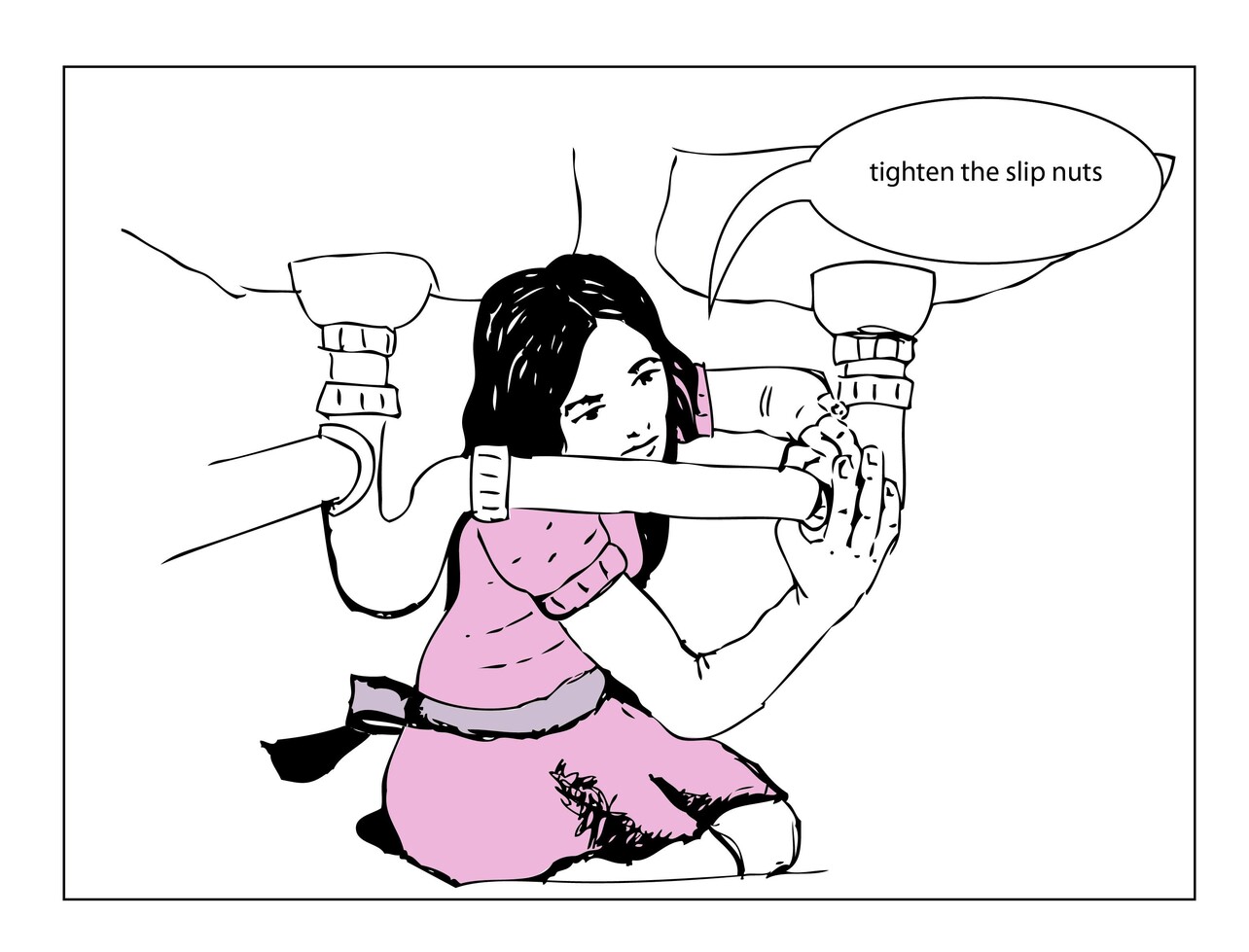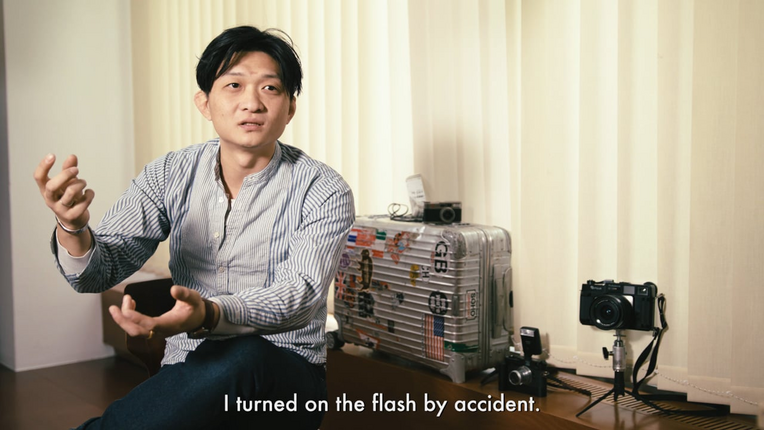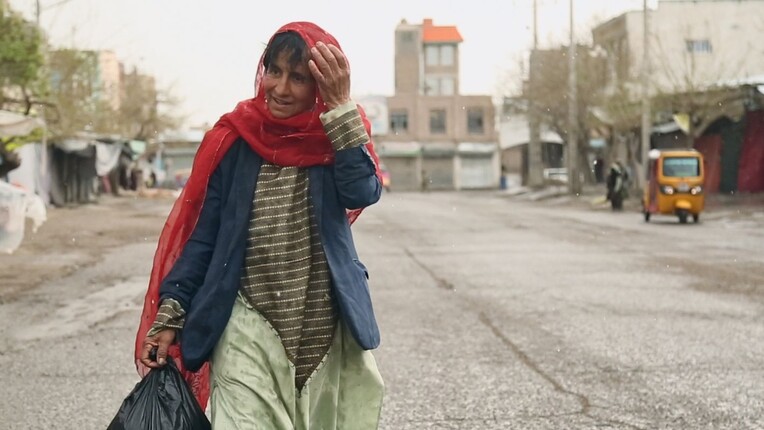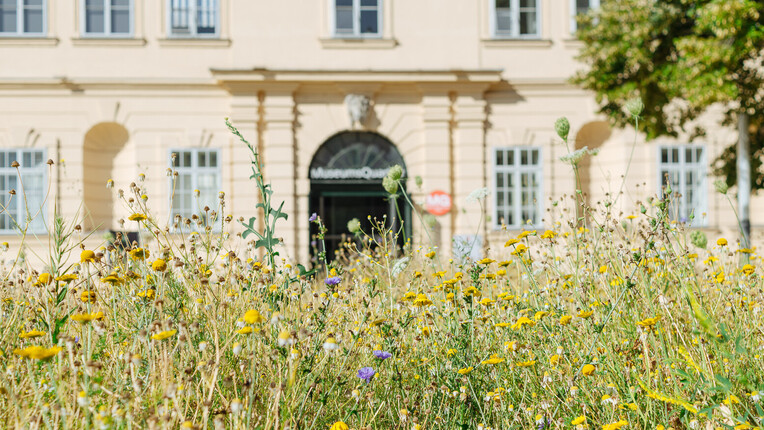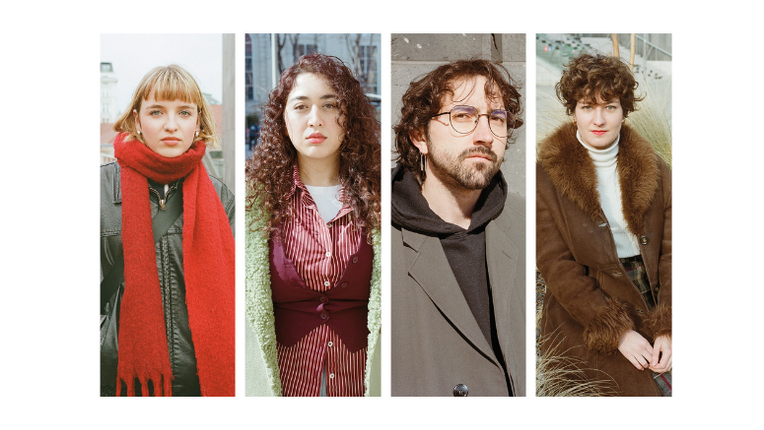
Besucherbefragung “Productive Work – What is it supposed to be?”
We asked our visitors what their favourite piece is, how they like the exhibition and how they think the shown art works relate to the title of the exhibition. This is how they responded.
We asked our visitors what their favourite piece is, how they like the exhibition and how they think the shown artworks relate to the title of the exhibition. This is how they responded.
Anna from Athens:
Favourite art piece: Dariia Kuzmych & Svitlana Selezneva: “Diploma Thesis”
“I really like the tapestry and are those traditional outfits? I like the colours, I’m not sure how to explain it exactly. The presentation, the colour combination, the subject. I also found the old photo collection of Prague very interesting (Jiří Kovanda, Photo Series) I’ve never been but I’d like to go.“ I think the exhibition is really nice, really interesting. I found the first part a little bit confusing, I think I like this part a little better [Anm: the “small room”].
Regina aus Wien:
Lieblingswerk: Dariia Kuzymch und Svitlana Selezneva: "Diploma Thesis"
Die Bilder aus Quilt-Technik und die Landkarte sowie das Bild der kleinen Stadt von Dariia Kuzmych und Svitlana Seleznova haben mir am besten gefallen und das verbinde ich auch am meisten mit dem Titel der Ausstellung, weil es für mich wirklich eine produktive Arbeit darstellt.
Eliška from Prague:
Favourite art piece: Jiří Kovanda, Photo Series
“I got interested when I – obviously – saw that it is from the Czech Republic and it seemed interesting that it’s in the Czech language so I felt like – ok, I’m going to read it because obviously I have a different approach to it than other tourists who are not from our country. And when I saw the date, I was like: ok, this is obviously gonna be from the communist era, and it was like a terrifying time of our history.
Well…at that time, people tried to act, to look in a certain way “normal” to the political world because obviously, other opinions, liberal opinions were prohibited. So, I feel like this is a non-violent way to how to tell people what to think about the communist propaganda and the boycott situation in real life, since there are hidden messages – sometimes it’s like – you won’t really understand it because you’re not Czech, but there are somehow hidden passwords in those messages. For example this one [the fourth from the right] from 1977 when there was a really bad time for the people in the Czech Republic, and it says “I’m walking carefully, like on a thin ice that can crack any moment”. It’s obviously about the police, watching every movement of the people against the communist regime, so you had to be really careful not to say anything unallowed on the street, because they would arrest you immediately and you would go to prison. I feel like “productive work” in this case means something simple, but with a strong message.”
Barbara from São Paulo:
Favourite art piece: Alicja Rogalska: “Tear Dealer”
“Tear Dealer” caught my attention because it’s too sad that somebody is trying to evoke your bad feelings to have money in a bad economy. I think a person who is underprivileged needs the money. Or maybe they are doing it for art. But I think the major part is doing it for money. I would not do this. I would not try to evoke my feelings, to be sad to get money. When it’s supposed to make you happy.
Maybe it feels good to participate in this kind of spirit though. She [Anm: the artist] is trying to show some point… I don’t know, maybe: you can make money with selling your feelings. When I’m in an exhibition space I’m drawn to something that evokes something. This one is really good, it made me think. But I really like to visit galleries to get references for work. I studied Industrial Design. I’m interested in new shapes, new colours, new ways of doing things. That’s what I’m always looking for. I really enjoyed the exhibition as a whole. I think the artists ask good questions, the way they show them.”
Christian aus dem Burgenland:
Lieblingswerk: Alicja Rogalska "Tear Dealer"
Tear Dealer von Alicja Rogalska und Lukasz Surowiec ist das beste Werk der Ausstellung, weil es skurril ist und zum Nachdenken anregt. Wie weit geht man, wenn man in solchen Umständen lebt, dass man quasi sein eigenes Leid in Form von Tränen verkauft!
"I dare you to..." von Tihana Mandusic verbinde ich am ehesten mit dem Titel der Ausstellung. Es ist ziemlich beschreibend für die allgemeine Haltung gegenüber zeitgenössischer Kunst.
Shanshan aus Dresden:
Lieblingsarbeit: Borjana Ventzislavova: „Inspiration, my world’s vibration“
„Ich finde die Ausstellung sehr interessant, obwohl ich nicht so der künstlerische Typ bin. Aber das Thema finde ich sehr interessant. Ich habe bis jetzt nur diese drei (Dražić, Ventzislavova, Simčić) ausführlich angesehen, aber den Text dazu noch nicht ganz gelesen. Der Titel ist „Productive Work“? Ich weiß nicht, ob es einen Zusammenhang zwischen den Werken gibt.“
Jakob aus Nürnberg/Düsseldorf:
Lieblingsarbeit: Iva Simčić „3:2“
„Ich habe noch nicht alles gesehen, aber das hier find ich gut. Mir gefallen die Bilder. Ich kenn auch die Situation. Vielleicht kann ich mich deshalb auch damit identifizieren. Das, was hier in diesem Katalog stand, ich weiß ich nicht, ob ich da so viel hineininterpretieren würde. Ich finde die Bilder nicht deswegen interessant, sondern einfach weil ich sie schön finde.
Wie man das mit dem Ausstellungstitel in Verbindung bringen soll, hm, klar, die hat ja irgendwas produziert, die Künstlerin, ne? Ob es jetzt Arbeit für sie war oder Spaß, das ist die Frage. Alles ist Arbeit. Liebe ist Arbeit. Und Künstler sagen ja auch: Ich muss jetzt noch eine „Arbeit“ machen.“
Tajana from Croatia:
Favorite art piece: Nina Kurtela & Hana Erdman “365 routines”
This exhibition is very diverse. Different artworks interact, some complement each other, while other confront each other observing productivity from very different angles.There are artworks that provide high aesthetics such as the “Golden Fingers of Louvre” by Igor Eškinja. I'm thrilled how banal fingerprints on the glass doors of the museum can be transformed into outstanding abstract peace of art with almost baroque atmosphere. Similar as romantic artwork "Seaside" by Dušica Dražić, who turns lines of a single pen into a poetic walk to the seaside. Artworks of Eškinja and Dražić oppose artworks packed with social activism, urging on review of social values. Some of artworks review a topic of work values in the era of capitalism. In the artwork "3: 2" by Iva Simčić it is shown how worker merges with his activity so that they become one and inseparable. This question is further problematized through the artwork "Measure for measure" by Irena Sladoje and Iva Simčić in which they discuss the empirical evidence of quantity and quality of thoughts, so as the end product of this process – is it possible that we are actually selling ourselves and not our work?
The artwork "Bone Work" by Christina Lammer suggests technology can give solution for such problems. It is true that the latest medical and technological discoveries can help to replace overused parts of the body. But is this possible without any consequences? Aren’t we losing the connection with our body, when each part can be replaced, upgraded and refreshed like the latest gadget? These are just some of questions that this artwork has presented to me since I am dealing with maintaining of work and life balance on a daily basis. As Holistic Feng Shui consultant, I think that to achieve such balance, moderation is of most importance.
And to end in the spirit of magical realism which emanates from artwork "365 routines" by Nina Kurtela and Hana Erdman who impressed me with their ecstatic dance, giving me hope that there are people for whom productive work is not just numbers and statistics, but ability to inspire and create.
Luisa from Brasil:
Favourite art piece: Irena Sladoje, Iva Simčić “Measure for Measure”, “Time off”
“I really like this piece (Sladoje, Simčić) that questions the productivity of art, especially the video (“Time off”), and the explanation. And this one also that is related to the bar, that white box space (Christina Lammer, Bone Work). I think right now these speak to me the most.
I can also see the correlation between the works and the title of the exhibition. More or less. I think it’s also very concerned with modern art. And leisure, I’m not sure. I haven’t seen much of “Productive Work” in sense of capitalism. It’s kind of explained from the other side. “Non valid” productive work.
Albiona aus Mazedonien:
Lieblingswerk: Irena Saldoje und Iva Simčić: "Measure for Measure"
Mir gefallen die kleinen Büchlein von Irena Saldoje und Iva Simčić am besten, weil sie so simpel sind aber gleichzeitig haben sie mich auf den ersten Blick angezogen und fasziniert. Sie sind so einfach und gerade deshalb sehr interessant. Dieses Kunstwerk passt für mich auch am besten zum Titel der Ausstellung.
Sven aus Hamburg:
Lieblingswerk: Christina Lammer "Bone Work"
Bone Work von Christina Lammer hat mir am besten gefallen. Die Hüftkugel hat die Künstlerin durch ihr Leben begleitet und gute Dienste geleistet, produktive Arbeit. Jetzt als er nicht mehr zu gebrauchen ist, wird der Knochen durch produktive, künstlerische Arbeit zu einem Kunstwerk in Form der bunten Abdrücke und hat so noch einen weiteren Sinn bekommen.
Beata aus Wien:
Lieblingswerk: Manual for house repairs for women von Nika Rukavina
Der roten Stuhl und das Buch von Nika Rukavina Manual for house repairs for women, gefällt mir als Szene in der Ausstellung am besten!
Das schönste, ansprechendste Kunstwerk sind die Bilder in Quilt-Technik von Dariia Kuzmych und Svitlana Seleznova. Am meisten mit dem Titel der Ausstellung verbinde ich das Video Time Off von Irena Sladoje und Iva Simcic, weil eine Frau sehr fleißig arbeitet und die andere nicht. Produktivität und das Gegenteil davon werden sehr gut gegenüber gestellt. Generell hat mir die Ausstellung sehr gut gefallen, vor allem weil die Kunstwerke aus verschiedenen Stilen sind, also Gemälde, Fotos, Videos, Performances, Bilder und Bilder in Quilt-Technik. Das finde ich besonders interessant und ansprechend.
Maria aus Italien:
Lieblingswerk: Nika Rukavina "Manual for home repairs for women"
Manual for home repairs von Nika Rukavina hat mir am besten gefallen und passt für mich auch am besten zum Titel der Ausstellung. Es hat mir am besten gefallen, weil es ein Kunstwerk ist, das im Alltag hilfreich ist und nicht nur ein Kunstwerk, das man betrachten kann. Es ist eine produktive Arbeit, weil es viel Zeit und Erfahrung braucht die handwerklichen Tipps zusammenzustellen und es ist nützlich für andere um eine produktive Arbeit in Form einer Reparatur verrichten zu können.
